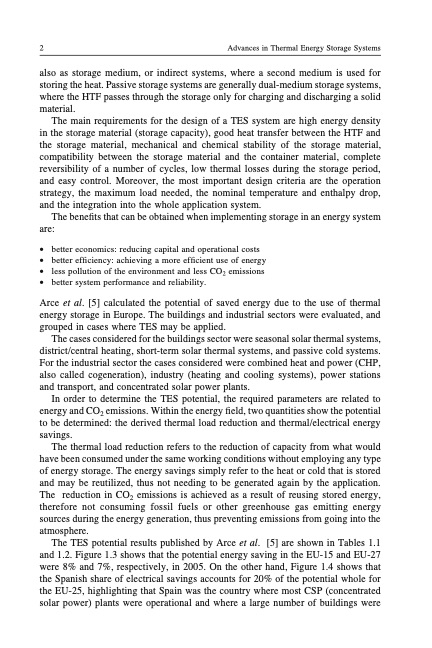
PDF Publication Title:
Text from PDF Page: 002
2 Advances in Thermal Energy Storage Systems also as storage medium, or indirect systems, where a second medium is used for storing the heat. Passive storage systems are generally dual-medium storage systems, where the HTF passes through the storage only for charging and discharging a solid material. The main requirements for the design of a TES system are high energy density in the storage material (storage capacity), good heat transfer between the HTF and the storage material, mechanical and chemical stability of the storage material, compatibility between the storage material and the container material, complete reversibility of a number of cycles, low thermal losses during the storage period, and easy control. Moreover, the most important design criteria are the operation strategy, the maximum load needed, the nominal temperature and enthalpy drop, and the integration into the whole application system. The benefits that can be obtained when implementing storage in an energy system are: ∑ better economics: reducing capital and operational costs ∑ better efficiency: achieving a more efficient use of energy ∑ less pollution of the environment and less CO2 emissions ∑ better system performance and reliability. Arce et al. [5] calculated the potential of saved energy due to the use of thermal energy storage in Europe. The buildings and industrial sectors were evaluated, and grouped in cases where TES may be applied. The cases considered for the buildings sector were seasonal solar thermal systems, district/central heating, short-term solar thermal systems, and passive cold systems. For the industrial sector the cases considered were combined heat and power (CHP, also called cogeneration), industry (heating and cooling systems), power stations and transport, and concentrated solar power plants. In order to determine the TES potential, the required parameters are related to energy and CO2 emissions. Within the energy field, two quantities show the potential to be determined: the derived thermal load reduction and thermal/electrical energy savings. The thermal load reduction refers to the reduction of capacity from what would have been consumed under the same working conditions without employing any type of energy storage. The energy savings simply refer to the heat or cold that is stored and may be reutilized, thus not needing to be generated again by the application. The reduction in CO2 emissions is achieved as a result of reusing stored energy, therefore not consuming fossil fuels or other greenhouse gas emitting energy sources during the energy generation, thus preventing emissions from going into the atmosphere. The TES potential results published by Arce et al. [5] are shown in Tables 1.1 and 1.2. Figure 1.3 shows that the potential energy saving in the EU-15 and EU-27 were 8% and 7%, respectively, in 2005. On the other hand, Figure 1.4 shows that the Spanish share of electrical savings accounts for 20% of the potential whole for the EU-25, highlighting that Spain was the country where most CSP (concentrated solar power) plants were operational and where a large number of buildings werePDF Image | Introduction to thermal energy storage TES systems

PDF Search Title:
Introduction to thermal energy storage TES systemsOriginal File Name Searched:
TES-introduction.pdfDIY PDF Search: Google It | Yahoo | Bing
Turbine and System Plans CAD CAM: Special for this month, any plans are $10,000 for complete Cad/Cam blueprints. License is for one build. Try before you buy a production license. More Info
Waste Heat Power Technology: Organic Rankine Cycle uses waste heat to make electricity, shaft horsepower and cooling. More Info
All Turbine and System Products: Infinity Turbine ORD systems, turbine generator sets, build plans and more to use your waste heat from 30C to 100C. More Info
CO2 Phase Change Demonstrator: CO2 goes supercritical at 30 C. This is a experimental platform which you can use to demonstrate phase change with low heat. Includes integration area for small CO2 turbine, static generator, and more. This can also be used for a GTL Gas to Liquids experimental platform. More Info
Introducing the Infinity Turbine Products Infinity Turbine develops and builds systems for making power from waste heat. It also is working on innovative strategies for storing, making, and deploying energy. More Info
Need Strategy? Use our Consulting and analyst services Infinity Turbine LLC is pleased to announce its consulting and analyst services. We have worked in the renewable energy industry as a researcher, developing sales and markets, along with may inventions and innovations. More Info
Made in USA with Global Energy Millennial Web Engine These pages were made with the Global Energy Web PDF Engine using Filemaker (Claris) software.
Sand Battery Sand and Paraffin for TES Thermo Energy Storage More Info
| CONTACT TEL: 608-238-6001 Email: greg@infinityturbine.com | RSS | AMP |